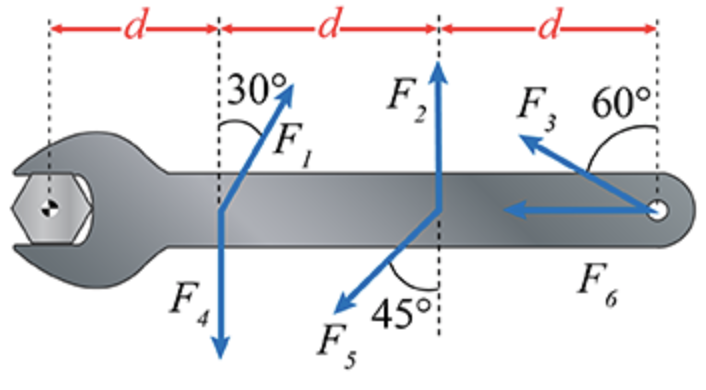A wrench is used to apply a torque to a bolt. Forces F1 through F6 all have the same magnitude. The point of application of force F1 (and F4) is a distance d from the center of rotation of the bolt. The application points of F1, F2, and F3 are all distance d apart, as shown. Use the convention that counter-clockwise torques are positive; clockwise torques are negative. Part (a) Determine the torque applied on the bolt by F1 in terms of the variables and angles given in the problem. Part (b) Determine the torque applied on the bolt by F2 in terms of the variables and angles given in the problem. Part (c) Determine the torque applied on the bolt by F3 in terms of the variables and angles given in the problem. Part (d) Determine the torque applied on the bolt by F4 in terms of the variables and angles given in the problem. Part (e) Determine the torque applied on the bolt by F5 in terms of the variables and angles given in the problem. Part (f) Determine the torque applied on the bolt by F6 in terms of the variables and angles given in the problem.
A wrench is used to apply a torque to a bolt. Forces F1 through F6 all have the same magnitude. The point of application of force F1 (and F4) is a distance d from the center of rotation of the bolt. The application points of F1, F2, and F3 are all distance d apart, as shown. Use the convention that counter-clockwise torques are positive; clockwise torques are negative.
Part (a) Determine the torque applied on the bolt by F1 in terms of the variables and angles given in the problem.
Part (b) Determine the torque applied on the bolt by F2 in terms of the variables and angles given in the problem.
Part (c) Determine the torque applied on the bolt by F3 in terms of the variables and angles given in the problem.
Part (d) Determine the torque applied on the bolt by F4 in terms of the variables and angles given in the problem.
Part (e) Determine the torque applied on the bolt by F5 in terms of the variables and angles given in the problem.
Part (f) Determine the torque applied on the bolt by F6 in terms of the variables and angles given in the problem.

Trending now
This is a popular solution!
Step by step
Solved in 4 steps with 1 images







